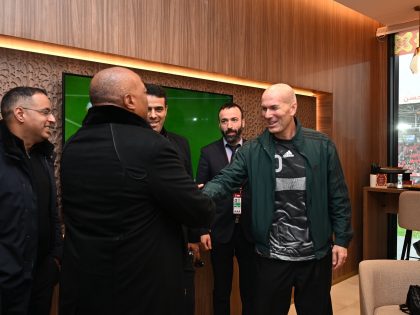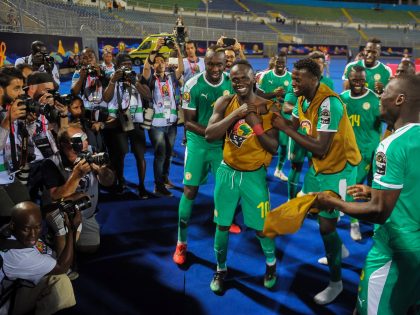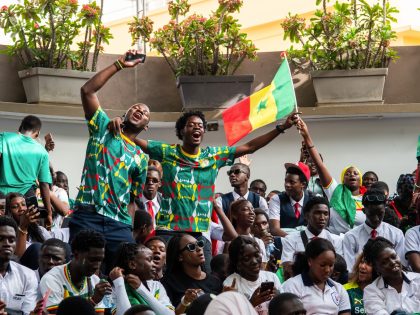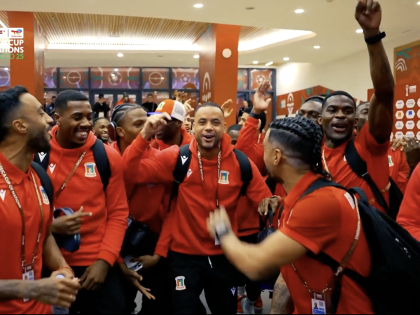Nicholas Kristof can’t find grown-up Africans to pose with him
Also how Call of Duty gets the white South African mercenary accents in its game right. Weekend Special is here.

Nicholas Kristof is on the left. The American actress, Eve Mendes, is in the middle (Half the Sky).
We didn’t have time to give proper attention to these posts. So we do them this way. First up, fresh from bringing young couples together in Kenya and leading the revolution down on Wall Street, Nicholas Kristof is now in Sierra Leone. As he informed his fans on Facebook, “… I’m in Sierra Leone partly to shoot the Half the Sky PBS documentary, along with the actress Eva Mendes. Here we’re in a village in eastern Sierra Leone with some of the awesome kids. I’m going to have to search Eva’s luggage as we leave to make sure she doesn’t abduct one or two of them!”
Anyway, he still can’t find grown-up Africans to pose with him.
On April 4, 2004, musician Gito Baloi, was walking, on his way back from a concert, on the corner of Kerk and Nugget Streets in Doornfontein, Johannesburg when he was gunned down. One of Baloi’s popular songs was called “No Ku Ranza.” Until recently the phrase “GITO BALOI NA KU RANZA” was spray painted on a wall at the spot where he was murdered. The area is favored by Southern African migrants (buses leave from there to Lusaka) and it’s seen its fair share of xenophobic violence. Now a group of artist–coordinated by the Center for Historical Reenactments in Johannesburg has embarked on an arts project on the site. In this video we get a sense of the project. That’s CHR’s Gabi Ngcobo (she studied at Bard College; good to see her doing well) giving a street lecture in the video.
They even got the accents of the white South African mercenaries right in this ‘short film’ to promote video game Call of Duty: Modern Warfare. Though at times it sounds like the accents in Lethal Weapon 2.
Now every foreign journalist visiting South Africa has to stop in Diepsloot, a massive squatter camp in Soweto, after the The New York Times went there. (There’s also a book by a South African journalist about the area.) Now it’s the turn of the British Channel 4. Anybody seen it? It is being broadcast this weekend.
Toronto’s imagineNATIVE film and media arts festival (October 19-23) has a focus on “the Khoi-San,” basically films about coloured life worlds in South Africa. Films like “Ongeriewe,” “The Fashion Gap,” and “Jitsvinger: Maak it Aan, about the Cape Town rapper. They’re also screening “The Uprising of Hangberg” and “Shirley Adams.” I’ll unpack the whole Khoi-San thing another time. Here‘s a link to the full schedule.
Beautiful short video profile of the Malian singer Boubacar Traoré by New York Times music writer Jon Pareles.
Photographer Brent Stirton’s “Timbuktu Today” series. Example:
 This summer Neelika Jayawardane interviewed Riason Naidoo, the director the South African National Gallery, about his work on recovering the popular history of Indians in South Africa. She was then ask by Caravan Magazine to write about Naidoo’s work. The full piece is here.
This summer Neelika Jayawardane interviewed Riason Naidoo, the director the South African National Gallery, about his work on recovering the popular history of Indians in South Africa. She was then ask by Caravan Magazine to write about Naidoo’s work. The full piece is here.
I recently came across a series of portraits by Swedish photographer Elisabeth Ohlson Wallin of a group of HIV positive South Africans entitled “Via Dolorossa” that depicts “suffering, endeavor and love in a South Africa afflicted with HIV and Aids.” Sample:
 I’ve praised Kenya’s NTV here before for archiving all its reports on its Youtube channel, including the excellent Red Eye. Now I’ve discovered the Youtube channel of Zambia’s Muvi TV and its own video player. The production values are not as slick as the Kenyans, but it’s worth a regular check-in.
I’ve praised Kenya’s NTV here before for archiving all its reports on its Youtube channel, including the excellent Red Eye. Now I’ve discovered the Youtube channel of Zambia’s Muvi TV and its own video player. The production values are not as slick as the Kenyans, but it’s worth a regular check-in.
Alec Russell, a former Financial Times “man in South Africa” had an op-ed about Julius Malema in the paper on Monday. It’s the usual slant: Malema is the biggest threat to investment in South Africa. Seriously. It’s also really about how Malema will spoil Russell’s annual trek down to the Cape Town Mining Indaba held every February in that city. A time for deals to be struck and Cape wines to be consumed, “all in a Mediterranean summer climate.” Russell also mentions a new book, Inconvenient Youth, by a South African journalist, Fiona Forde, on Malema. They churn out books in South Africa like newspapers.
This weekend–or sometime soon–I hope to catch the “Heroic Africans: Legendary Leaders, Iconic Sculptures” exhibit at The Metropolitan Museum in New York City. On show are 100 sculptures representing “eight landmark sculptural traditions from West and Central Africa created between the twelfth and early twentieth centuries” and a glimpse into the world of power before European colonialism. It’s showing till January 22, 2012. If it matters, The New York Times’ art critic strongly recommend it on the front page of the Arts Section.
If you care about theoretical debates about media practices, I’d strongly recommend the website for FLOW TV, “… a critical forum on television and media culture” published the University of Texas’ Department of Radio, Television, and Film. It features a lot of work of media studies graduate students around the US. Like this piece by Daniel Munro on the media of the Libyan rebel movement. Munro argues that global TV news (including Al Jazeera English) hardly engaged with locals beyond “major moments of violence or celebration.” Digging through online video sharing sites and search engines, he finds “imagery of amateur footage [that] offers views of the revolution between battles that are not typically televised.” Unfortunately few people get to watch these. Mauro also finds that the most active and expansive set of amateur videos of rebel activity is the work of an American computer technician, Humphrey Cheung, who infiltrated with rebels from Tunisia. Here‘s a link to the article. And here‘s a link to Cheung’s set of videos. (BTW, this is not the “clueless” American student who thought it was cool to buy a one-way plane ticket to Cairo and sneaked into Libya to join the rebels because it would make for a cool summer break.)
Remember when famed photographer Roy Zipstein traveled to Durban before the 2010 World Cup and shot a spread for a design magazine on the new Moses Mabhida stadium? And you marveled, right. So did we.
 Well, the stadium is operating at a lost. If you want to read more about the politics of stadium construction in South Africa, I’d suggest checking out the work of historian Peter Alegi: his academic research here (on stadium construction in Cape Town and Durban) and on his blog, here. Oh, and what about Soccer City?
Well, the stadium is operating at a lost. If you want to read more about the politics of stadium construction in South Africa, I’d suggest checking out the work of historian Peter Alegi: his academic research here (on stadium construction in Cape Town and Durban) and on his blog, here. Oh, and what about Soccer City?
This video’s been around for a while. Check out the contestants in last year’s Miss West Africa eating crabs.
Finally, the Big Weekend Music Break.
First some political music: David Patrick Lane introduced me to British post-punk band, The Three Johns (we were talking football), especially to the group’s 1982 single, “English White Boy Engineer” which attacked hypocritical attitudes towards South Africa and Apartheid in the UK. Salute.
Now back to your regular programming.
I can dig this Kenyan music everyday. The video for Redrepublik’s “Skamaress.”
Here’s The beautiful video for Baltimore’s Future Islands’ “Balance” from their new EP.
Rohff, the French rapper of Cape Verdean descent, has a dream of throwing a “Thug Marriage” somewhere in a Gulf state. The singer Indila contributes melodies.
More pop. This time Ghanaians Scorpy Sekelism, Skrew Face, Old Sodja and D-Flex with “Georgina Remix“.
Speeding things up with French DJ Frederic Galliano and Kuduro Sound System’s “1,2,3 sempre tabater” from this past summer.
The Zambian group., Zone Fam, with “Mbama“:
Stella Mwangi was born in Kenya and grew up in Norway. This would usually make me leave the dance floor behind.
If Kenyans have Stella (well, more like Stella wants Kenya to notice her), Mozambique has Lizha James. You can hear the South African influences.
Slowing things down a little. First the Cuban-born, Cape Verdean singer Mayra Andrade.
Corneille is a Rwandan-German crooner. This is “Le jour après la fin du Monde“.
Rotterdam-based Cape Verdean-Dutch rapper Gary Mendes decided to turn his haircut into a music video (first spotted late last year).
Finally, who cares if this has nothing to do with Africa, but I really dig the German Youtube channel, TV Noir, a collection of live acoustic performances. Like the tune “Railway” by the group BOY.



















